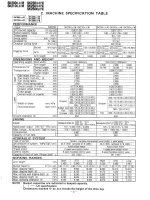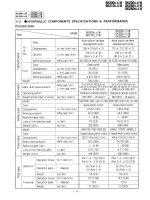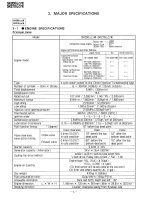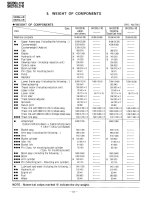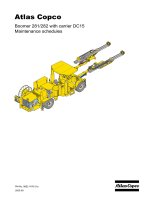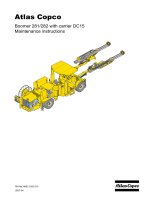Shop manual máy khoan hầm Boomer H282 (Phần 5)
Bạn đang xem bản rút gọn của tài liệu. Xem và tải ngay bản đầy đủ của tài liệu tại đây (647.6 KB, 16 trang )
Reg. code
AIB TAB 43
COP 1638
2007–08
Maintenance instructions for
Hydraulic
Rock drill COP 1638
1250 0021 33
ATLAS COPCO ROCK DRILLS AB
ÖREBRO · SWEDEN
© Atlas Copco Rock Drills AB, 2007. All rights reserved.
No. 9852 1653 01c
SAFETY REGULATIONS
·
Important safety information is given at various points in these instructions.
·
Special attention must be paid to the safety information contained in frames and accompanied by a war-
ning symbol (triangle) and a signal word, as shown below:
indicates hazards or hazardous procedures which COULD
result in serious or fatal injury if the warning is not observed.
indicates hazards or hazardous procedures which COULD
result in injury or damage to equipment if the warning is not
observed.
The following safety rules must also be observed:
·
Carefully read through all operating- and main-
tenance instructions for the drill rig and rock
drill before putting the rock drill to use. Always
follow the instructions given.
·
Do not use or intervene in the rock drill unless
you have been trained to do so.
·
The rock drill may only be used for the pre-
scribed purposes.
·
Make sure that the drill rig has been maintai-
ned in accordance with the current instructions.
·
Make sure that all safety labels remain in pla-
ce, and that they are kept clean and fully legib-
le. See the spare parts list for details of label
locations and part numbers.
·
Always wear a safety helmet and ear protec-
tors during drilling. Any local regulations that
exist must also be observed.
·
Before moving the drill rig or starting to drill,
make sure that there are no personnel in the
immediate vicinity of the drill rig.
·
Use Atlas Copco genuine parts only. Any
damage or malfunction caused by the use of
unauthorized parts is not covered by Warranty
or Product Liability.
·
Never attempt to carry out maintenance while
the drill rig is in operation.
·
Those checks and adjustments that must be
made while the drill rig is in operation must be
carried out by at least two persons. One per-
son must man the control station and keep a
strict watch over the work.
·
To prevent injury during service and mainte-
nance, all components that could possibly
move or drop must be supported safely on
blocks or trestles, or secured by means of
adequately dimensioned slings.
·
Before starting work on any of the systems,
make sure that the hydraulic, air and water sys-
tems are without pressure, and that the electri-
cal system is dead.
·
Check that the hoses used are of the right qua-
lity, and that all hose connections are in good
condition and properly tightened.
WARNING
CAUTION
Contents Page
Safety regulations . . . . . . . . . . . . . . . . 2
Action list . . . . . . . . . . . . . . . . . . . . . 3
Hose connections . . . . . . . . . . . . . . . . 4
Tightening torques . . . . . . . . . . . . . . . . 5
Accumulators . . . . . . . . . . . . . . . . . . 6
– Charging the accumulators . . . . . . . . . . 6
– Checks in the event of hose vibration . . . . . 7
– Changing the accumulators . . . . . . . . . . 8
– Changing the return accumulator . . . . . . . 9
Changing the hydraulic motor . . . . . . . . . . 9
Filling with lubricating oil and bleeding the syst. 10
Setting of ECL lubricating system . . . . . . . 10
Lubrication of gear . . . . . . . . . . . . . . . 11
Setting the damper pressure . . . . . . . . . . 11
Removing the front head . . . . . . . . . . . . 12
Checking the front head . . . . . . . . . . . . 13
Changing the flushing head and driver . . . . 14
Mounting the front head . . . . . . . . . . . . 14
Slinging . . . . . . . . . . . . . . . . . . . . 15
Long-term storage . . . . . . . . . . . . . . . 15
Recommended hydraulic oils and lubricants . 16
2
Action list
Before starting up a new- or
newly overhauled rock drill: Page
·
Connect up the hoses . . . . . . . . . . . . 4
·
Charge the accumulators . . . . . . . . . . . 6
·
Select a suitable hydraulic oil and lubricant . 16
·
Fill the lubricating system with oil . . . . . . . 10
·
Adjust and set the lubricating system . . . . 10
·
Set the damper pressure . . . . . . . . . . . 11
Every shift
·
Check that air and lubricating oil come out
between the shank adapter and front guide
and also out of the hole in the front head . . 13
·
Check that the damper-pressure gauge on
the drill rig shows the normal value. In case
of deviation, adjust the damper pressure . . . 11
·
Check that the shank-adapter threads are
not damaged . . . . . . . . . . . . . . . . . 13
·
Keep an eye on the hydraulic hoses. If they
vibrate too much, check the accumulators . . 7
·
Check that there is no leakage from the rock
drill. If the flushing medium leaks out of the
overflow hole in the front head, change the
seals and O-rings . . . . . . . . . . . . . . . 13
·
When changing the shank adapter or remov-
ing the front head, check the internal compo-
nents, including the visible parts of the piston,
driver and rotation chuck bushing . . . . . . 13
In the event of defect, remove to a suitable
workshop for repair or replacement.
After the first shift when using a
new- or newly overhauled rock drill
·
Tighten all threaded unions . . . . . . . . . 5
After every 40th percussion-hour
·
Grease the gear . . . . . . . . . . . . . . . 11
·
Tighten all threaded unions . . . . . . . . . 5
·
Check the safety labels on the accumulators.
Replace them if they are damaged or illegible . 6
·
Check the return accumulator . . . . . . . . 7
Every 400th percussion-hour:
·
Remove the rock drill from the drill rig and
send it to a suitable workshop for over-
hauling*.
* The rock drill should be overhauled at suitable intervals,
based on local conditions. The characteristics of the rock will
have a great influence on the rate of wear, and thus on the
required frequency of overhauling.
IMPORTANT
·
Observe great cleanliness when interve-
ning in the rock drill or its hydraulic cir-
cuit.
·
The following parts may be changed at the
worksite in accordance with the instruc-
tions given:
– shank adapter
– driver
– front head parts
– accumulators
– hydraulic motor
– screws
– connections.
Other repairs must be carried out in a sui-
table workshop in accordance with the
WARNING
·
Before starting any maintenance work,
make sure that the electrical system is
dead.
There is a risk of injury if these instructions
are not observed!
CAUTION
·
Take care during rod jointing and when
handling the drill bit. Mind your fingers!
·
Keep your clothing away from rotating
machine parts.
Carelessness can lead to serious injury.
·
Always use ear protectors during drilling.
High noise levels damage hearing.
·
Never attempt maintenance or intervene
in the rock drill, connections or hoses whi-
le the hydraulic, lubrication or flushing
systems are pressurized.
Air or oil can squirt out at high pressure
and high temperature, with the risk of
serious injury to the eyes and skin.
3
Hose connections
1. Drainage
2. Rotation to the left
3. Rotation to the right
4. Percussion mechanism, return
5. Percussion mechanism, intake
6. Flushing air/water
7. Lubricating air
8. Damper, intake
Connecting the hoses
·
Clean the hose connections on the rock drill be-
fore removing the protective plugs (or caps).
·
Never remove a protective plug until the hose is
ready to be connected.
·
Always store the rock drill with all hose connec-
tions plugged. Use suitable protective plugs or
caps, and make sure that they are clean.
CAUTION
·
Never attempt maintenance or intervene
in the rock drill, connections or hoses whi-
le the hydraulic, lubrication or flushing
systems are pressurized.
Air or oil can squirt out at high pressure
and high temperature, with the risk of
serious injury to the eyes and skin.
·
Pressure hoses with an internal diameter
of 19 mm (3/4") or more are rated SAE 100
R9R (i.e. high-pressure hose with four lay-
ers of spirally wound steel-wire reinforce-
ment). See spare parts list for drill rig.
For safety reasons, these hoses must not,
under any circumstances, be replaced
with hoses of a lower rating.
There is a risk of injury if these instruc-
tions are not observed!
1250 0147 23
1
8
7
2
3
4
5
6
AIR
4
Tightening torques
N.B. Tighten item Nos. 1–3 in the prescribed order.
Ref.No. Qty. Check point Torque Instructions
Nm lbf.ft
1 2 Side bolts 300 220 Tighten the rear nuts
2 1 Front bolt 300 220 Tighten the front bolt
3 2 Side bolts 350 260 Tighten the front nuts
4 3 Back head 220 160 Tighten the screws alternately to full torque
(uppermost screw last)
5 1 Regulating plug 80 60
6 4 Accumulators 220 160 Tighten the screws alternately to full torque
7 4 Hydraulic motor 65 48 Tighten the nuts alternately
8 2 Clamping attachment,
return accumulator 30 22
9 4 Rock drill mounting 250 185 Tighten the screws alternately to full torque
10 1 Plug 45 33
11 4 Valve covers 145 105 Tighten the screws alternately to full torque
12 2 Connection plate 120 90 Tighten the screws alternately to full torque
13 1 Flushing connection 300 220
14 4 Inlet, flushing medium 90 65 Tighten the screws alternately to full torque
15 1 Intake, extractor unit 120 90
16 1 Return, extractor unit 120 90
1250 0147 24
4
5
1
6
7
8
9
10
11
12
6
9
13
3
14
3
2
5
Accumulators
The accumulators are fitted with safety labels as
shown in the figure below.
1. Damper accumulator
2. Intake accumulator
3. Return accumulator
4. Protective cap
5. Valve nut
6. Gas valve
Charging the accumulators
1. Remove the protective cap (4).
2. Open the valve nut (5) by 2–3 turns, and con-
nect the gas hose.
3. Open the gas valve (6).
4. Charge the accumulators to the correct
pressure, as follows:
– Damper accumulator (1): 20–25 bar
(290–360 psi)
– Intake accumulator (2): 30- 40 bar
below the collaring pressure
(435 - 580 psi)
5. Tighten the valve nut (5) and close the gas val-
ve (6).
6. Remove the gas hose and fit back the protecti-
ve cap (4) to the accumulator valve.
The return accumulator (3) must not be charged.
WARNING
·
The accumulators must be charged with
nitrogen (N
2
) only!
Other gases can cause an explosion.
CAUTION
·
Do NOT charge the accumulators until
they have been fitted to the rock drill.
There is a risk of injury if these instruc-
tions are not observed!
= Read the instruction book carefully
before servicing or changing
= Must be charged with nitrogen only
1250 0027 19
1250 0020 91
0
0
0
1
0
5
1
0
0
2
0
5
2
R
AB
0
0
0
1
0
5
1
0
0
2
0
5
2
R
A
B
0
0
0
1
0
5
1
0
0
2
0
5
2
R
A
B
1250 0175 94
2
3
4
5
6
1
6


